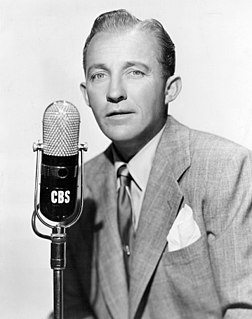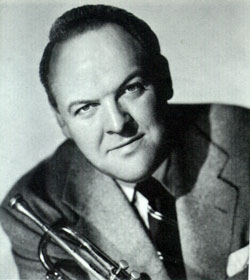Related Research Articles

Harry Lillis "Bing" Crosby Jr. was an American singer, comedian and actor. The first multimedia star, Crosby was a leader in record sales, radio ratings, and motion picture grosses from 1930 to 1954, he made over seventy feature films and recorded more than 1,600 different songs.

Paul Samuel Whiteman was an American bandleader, composer, orchestral director, and violist.

Mildred Bailey was a Native American jazz singer during the 1930s, known as "The Queen of Swing", "The Rockin' Chair Lady" and "Mrs. Swing". Some of her best-known hits are "For Sentimental Reasons", "It's So Peaceful in the Country", "Trust in Me", "Where Are You?", "I Let a Song Go Out of My Heart", "Small Fry", "Please Be Kind", "Darn That Dream", "Rockin' Chair", "Blame It on My Last Affair", and "Says My Heart". She had three singles that made number one on the popular charts.

Edward William May Jr. was an American composer, arranger and trumpeter. He composed film and television music for The Green Hornet (1966), The Mod Squad (1968), Batman, and Naked City (1960). He collaborated on films such as Pennies from Heaven (1981), and orchestrated Cocoon, and Cocoon: The Return, among others.
"What Is This Thing Called Love?" is a 1929 popular song written by Cole Porter, for the musical Wake Up and Dream. It was first performed by Elsie Carlisle in March 1929. The song has become a popular jazz standard and one of Porter's most often played compositions.
"If I Give My Heart to You" is a popular song written by Jimmy Brewster, Jimmie Crane, and Al Jacobs. The most popular versions of the song were recorded by Doris Day and by Denise Lor; both charted in 1954.
"On the Atchison, Topeka and the Santa Fe" is a popular song written by Harry Warren with lyrics by Johnny Mercer. The song was published in 1944, spanned the hit chart in mid-1945, and won the 1946 Academy Award for Best Original Song, the first win for Mercer.
"Ballerina" is a popular song, sometimes known as "Dance, Ballerina, Dance". The song was written by Carl Sigman with lyrics by Sidney Keith 'Bob' Russell. Published in 1947, the tune is listed as ASCAP Title Code 320012517.
"Friendly Persuasion " is a popular song with music by Dimitri Tiomkin and lyrics by Paul Francis Webster. It was published in 1956 and appeared in the 1956 film of the same name. At the 29th Academy Awards, Friendly Persuasion was nominated for the Best Music – Song but lost out to "Que Sera, Sera ".
"The Christmas Song" is a classic Christmas song written in 1945 by Robert Wells and Mel Tormé.

"White Christmas" is an Irving Berlin song reminiscing about an old-fashioned Christmas setting, released in 1942. The version sung by Bing Crosby is the world's best-selling single with estimated sales in excess of 50 million copies worldwide. When the figures for other versions of the song are added to Crosby's, sales of the song exceed 100 million.
"Deep Purple" was the biggest hit written by pianist Peter DeRose, who broadcast, 1923 to 1939, with May Singhi as "The Sweethearts of the Air" on the NBC radio network. "Deep Purple" was published in 1933 as a piano composition. The following year, Paul Whiteman had it scored for his suave "big band" orchestra that was "making a lady out of jazz" in Whiteman's phrase. "Deep Purple" became so popular in sheet music sales that Mitchell Parish added lyrics in 1938.
"(Love Is) The Tender Trap" is a popular song composed by Jimmy Van Heusen, with lyrics by Sammy Cahn.

The Rhythm Boys were an American male singing trio consisting of Bing Crosby, Harry Barris and Al Rinker. Crosby and Rinker began performing together in 1925 and were recruited by Paul Whiteman in late 1926. Pianist/singer/songwriter Barris joined the team in 1927. They made a number of recordings with the Whiteman Orchestra and released singles in their own right with Barris on piano. They appeared with the Whiteman orchestra in the film King of Jazz, in which they sang "Mississippi Mud", "So the Bluebirds and the Blackbirds Got Together", "A Bench in the Park", and "Happy Feet". They are best remembered for launching Crosby's solo career, one that would make him the greatest song charting act in history and one of the most influential entertainers of the twentieth century.

"Nobody's Sweetheart", also known as "Nobody's Sweetheart Now" and "You're Nobody's Sweetheart Now", is a popular song, written in 1924, with music by Billy Meyers and Elmer Schoebel, and lyrics by Gus Kahn and Ernie Erdman. The song is a jazz and pop standard.
"What's New?" is a 1939 popular song composed by Bob Haggart, with lyrics by Johnny Burke. It was originally an instrumental tune titled "I'm Free" by Haggart in 1938, when Haggart was a member of Bob Crosby and His Orchestra. The tune was written with a trumpet solo, meant to showcase the talents of band-mate Billy Butterfield. Crosby's orchestra recorded "I'm Free" the same day it was written.

"Whispering" is a popular song. "Whispering" was first published in 1920 by Sherman, Clay & Co., of San Francisco. The initial 1920 copyright and first publishing attributes the lyrics to Malvin Schonberger and the music to John Schonberger.
"Down by the Riverside" is a Negro spiritual. Its roots date back to before the American Civil War, though it was first published in 1918 in Plantation Melodies: A Collection of Modern, Popular and Old-time Negro-Songs of the Southland, Chicago, the Rodeheaver Company. The song has alternatively been known as “Ain' go'n' to study war no mo'”, “Ain't Gwine to Study War No More”, “Down by de Ribberside”, “Going to Pull My War-Clothes” and “Study war no more”. The song was first recorded by the Fisk University jubilee quartet in 1920, and there are at least 14 black gospel recordings before World War II.
"Among My Souvenirs" is a 1927 song with words by Edgar Leslie and music by Horatio Nicholls.
This is a list of Bing Crosby songs he recorded twice or more during his career, excluding all of the 1954 re-recordings for Bing: A Musical Autobiography.
References
- ↑ CD liner notes: Chart-Toppers of the Twenties, 1998 ASV Ltd.
- ↑ Pairpoint, Lionel. "And Here's Bing". BING magazine. International Club Crosby. Retrieved September 12, 2016.
- ↑ "A Bing Crosby Songography". BING magazine. International Club Crosby. Retrieved September 12, 2016.
- ↑ Davies, Chris (1998). British and American Hit Singles. London: BT Batsford. p. 70. ISBN 0-7134-8275-3.
- ↑ "45cat.com". 45cat.com. Retrieved May 1, 2017.
- ↑ Davies, Chris (1998). British and American Hit Singles. London: BT Batsford. p. 27. ISBN 0-7134-8275-3.
| This pop standards-related article is a stub. You can help Wikipedia by expanding it. |